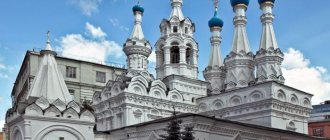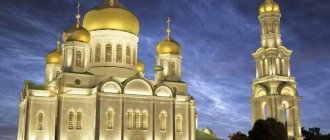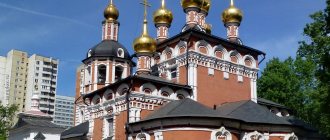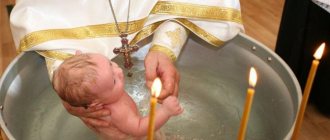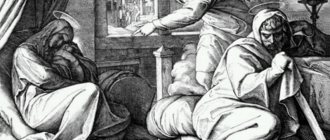Telegram channel @ieshua.org
Sometimes Christmas annoys me. No, I’m not at all a hater of Christmas and everything connected with it, in the spirit of the old miser Scrooge. What's the matter? The fact is that the most anticipated event in the history of the Jewish people - the coming of the Messiah - was taken away from us and distorted beyond recognition.
I am Jewish and I believe in Yeshua (Jesus), but I have long had a difficult relationship with Christmas. No, in fact, I really love the warm, bright atmosphere of the Christmas holidays: twinkling lights, the aroma of hot chocolate, cozy snow-covered landscapes and cheerful music. Last year I even tried making Christmas pudding. Like many American Jews, Christmas traditions were part of my childhood. But as I grew older, the warm and bright feelings in me weakened, giving way to growing anxiety.
People like to say that “Jesus is at the center of this holiday,” but I realized quite early on that it’s not that simple. Similar traditions were observed at this time of year long before His birth - at Saturnalia, the Roman festivals in honor of the winter solstice. So today we have a mixed, hybrid holiday established in the 4th century AD.
This year I couldn't stand it! I realized that I had to find out when Yeshua was actually born. Perhaps by understanding this, I will find a tradition that is truly worth keeping.
Where did the date December 25th come from?
According to early Messianic beliefs, Yeshua was born in the spring. The oldest known written source states that He was born "one hundred and ninety-four years, one month and thirteen days" before the death of the Roman Emperor Commodus (who died on December 31, 192), which gives us the date November 18.[1]
Our sages have long believed that tzaddikim (righteous people) die on the day of their birth[2]. Some historians, misinterpreting this ancient Jewish belief, insisted that Yeshua was born on December 25th. In the Christian interpretation, the birthday for some reason turned into the day of conception. Following this logic, if Yeshua died on March 25 (the most likely date, according to general opinion), then He was conceived on the same day. This means that He was supposed to be born exactly nine months later - on December 25th.
Anyway, I started my search for the birth date of Jesus with a Google search (which was a good idea), but the results quickly showed that all these traditions are based on long-outdated assumptions. If I want to find out the real date of Yeshua's birth, I will need scientific data. Then it dawned on me: the Magi came from the east in search of the newborn Messiah, following the star[3]. And if we can track the exact time of the appearance of this star, then it will be possible to establish the date of Yeshua’s birth.
There was no room in the hotel
(Luke 2:7-16)
She gave birth to her firstborn son and laid him in a manger.
A manger was a feeding trough, made of stone, where they put hay and grass and the sheep ate there. This manger looks a lot like Jesus' empty tomb.
In the tower of Gader, where there was an inn, there was no place for Him. And did Joseph try to achieve this place by telling his genealogy? No. There is power in putting everything into God's hands. All things work together for good to those who love God. God had to give a sign to the shepherds.
It was necessary to show the whole world that all the lambs sacrificed earlier all pointed to this baby. This is the Lamb of God who takes away the sin of the world.
Jewish references to the star of the Messiah
As it turned out, the “Christmas star” is of Jewish origin. For thousands of years, the coming of the Messiah was associated with the appearance of a star: “I see Him, but now not yet; I see Him, but not close. A star rises out of Jacob, and a rod rises out of Israel” (Numbers 24:17).
This prophecy was pronounced on Israel by the pagan sorcerer Balaam, when we were still in the desert. It was after this event that our sages began to believe that the birth of the Messiah would be announced by a star[4]. Many centuries later, Rabbi Akiva gave the name "Bar Kochba" to the leader of the armed uprising against the Romans, Shimon Bar Koseva, and declared him the Messiah.
“Rabbi Akkiva attributed the famous messianic prophecy to Shimon Bar Kochba: “a star rises from Jacob.” … That’s how he got the name “Kokhba”, which means “star””[5].
These expectations are also recorded in the Dead Sea Scrolls: “The Star is the Interpreter of the Law... for it is written: “A star rises out of Jacob, and a rod rises out of Israel.”[6] Similar opinions are mentioned in Philo of Alexandria[7], in the Peshitta, the Targums of Neophyti, Onkelos, Pseudo-Jonathan and the Fragmentary Targum, as well as in the testimonies of Judah and Levi in the Testaments of the Twelve Patriarchs[8].
Perhaps the most interesting mention of this phenomenon we find in the post-rabbinic midrash Agadat HaMashiach: “There is a teaching from the words of our sages [that] ... a star will rise in the east. This is the star of the Messiah..." The same source gives one of the most convincing descriptions of this coming star:
“A star will appear from the east and at the top of it will be a rod of fire, like a spear. The pagan nations will say, “This is our star,” but it is not so; it belongs to Israel, as predicted in Scripture: “a star rises from Jacob...” [9, 10].
Views on the Origin of Jesus
What is the true origin of the Messiah? In Christianity, it is generally accepted that, as stated in ancient prophecy, Jesus was the Son of God, born of the Immaculate Virgin and the Holy Spirit in Bethlehem.
They tried to explain the birth of the Savior at different times using a number of different alternative versions of his origin. Some of them completely contradicted the interpretation of the prophet Isaiah's prediction that the Messiah would be born of a virgin. This position was mainly occupied by Jews. They argued that Isaiah's prophetic words had nothing to do with the appearance of the Son of God because they referred to events coinciding with the time described in the prediction. Some secular scholars of the Holy Scriptures hold the same opinion.
As for the ancient era and the late anti-Christian polemics, they are characterized from the point of view of the birth of the Savior by extramarital affairs. Christians, as you might expect, dispute this hypothesis. At the same time, they point to contradictions, a number of circumstances described in the New Testament. In particular, this concerns the visit of Christ and those who are near his Temple in Jerusalem, as well as the description of his stay there at the age of 12 (read in the Gospel of Luke).
But even this does not prevent critics from holding on, that is, from doubting the authenticity of the New Testament. They are not stopped even by the fact that the Gospel was written by witnesses to everything that happened to Jesus. In addition, this book was created with the participation of the disciples of the Messiah, John and Matthew.
Modern theories
Okay, the star prophecy was well known, mentioned in many Jewish sources throughout history and associated with the coming of the Jewish Messiah. But is there any scientific evidence to prove that such a star actually appeared at the time of Yeshua’s birth? This is exactly what I wanted to find out.
I went back to my internet search and came across a video about the research of Dr Colin Nicholl from Oxford. And I also thought that I spent a lot of time on my research! Colin Nicholl, Doctor of Divinity, devoted ten years to studying astronomy to find out the truth about the Star of Bethlehem! From his book, I learned that the star that led the Magi to Bethlehem could actually be a comet (the biblical description of a “star” fully allows for such an interpretation). It seemed to me that his theory fits well with the description of the Messianic star among the rabbis, in particular, it explains the presence of a “rod of fire, like a spear.”
Nicholl argues that the comet appeared during a historically documented astronomical event when the constellation Virgo was aligned with the sun and moon on September 15, 6 BC. (1 Tishrei 3756). He calculated that Jesus was born on the day when this comet was “born” from the constellation Virgo - October 20, 6 (5/6 Cheshvan 3756)[11].
Dr. Nicholl kindly responded to a lengthy email I sent after reading his book. I had a lot of questions - especially after I became acquainted with other theories regarding the birth of the Messiah.
For example, with the book “The Conversion of Hermon” by Dr. Michael Heizer. In Chapter 4, Heiser outlines his theory about the Star of Bethlehem. He believes that this star was a visual effect of the conjunction in the sky of the planet Jupiter and the star Regulus. In 3 BC. A whole series of such conjunctions occurred, one of which occurred on September 11, 3 BC. (1 Tishrei 3759). It is this date that Heizer considers the true birthday of Yeshua[12]. He performed the calculations using special astronomical software. According to his theory, King Herod died in 1, and not in 4 BC, as most modern scholars believe. Although there is no consensus among Bible scholars about the date of Herod's death, they all agree that he was alive and reigning at the time of Jesus' birth.
Although the research of both of these scientists is extremely interesting, their theories will remain inconclusive if you are not aware of another piece of this puzzle - the sign of Virgo.
Prophet Micah's prediction
The land where the Savior was born is described in the Holy Scriptures. What does this tell us about this? The Collection of Holy Books indicates that this state was called the Kingdom of Judah or simply Judea, and Jerusalem was chosen as its capital. The kingdom was formed in the 10th century BC after the collapse of the Israeli kingdom of Solomon and David. Geographically, it covered the lands of the tribe of Simeon and Judah, as well as part of the lands of the tribe of Benjamin.
What does Holy Scripture say about the settlement where the Messiah was born? What kind of city is this in which the big event took place? The prophecy of Micah gives us information on this matter. It was created long before the birth of the Son of God, approximately 7 centuries before the birth of Christ.
The Gospel takes us back to the words of Micah, in particular to the part that was written by Matthew. This is the concern of King Herod. He was excited by the news of the birth of the king of the Jews. As you know, the Magi brought it to him. The ruler received this message for interpretation by those who study the Bible. He asked them to determine the name of the place where the Savior was born.
The expert response to the king included a quote from the prophecy of Micah. It was he who revealed to the world the secret of the city in which the Son of God was born, which is called Bethlehem. Interestingly, the same word is translated in different ways from Hebrew. It all depends on your writing. The phrase translated into Russian may sound like “house made of meat” or “house of bread.”
Virgo sign
A number of biblical theologians believe that in the 12th chapter of Revelation, John describes the heavenly phenomena that occurred at the time of the birth of the Messiah:
“And a great sign appeared in heaven: a woman clothed with the sun; under her feet is the moon, and on her head is a crown of twelve stars. She was with child, and cried out in pain and birth pangs” (John 12:1-2).
This description is not just vague symbolism, but the real position of the constellations, which was observed in the sky (even twice) in the period from 7 to 1 BC, in which Yeshua was born. The “woman” that John speaks of is the constellation Virgo. According to meteorologist and Bible scholar Ernest Martin, “The word sign that the author of Revelation used to describe the position of the stars in the sky is the same word that the ancient writers used to designate the zodiacal constellations.”[13]
Martin dates this phenomenon to September 11, 3 BC. (1 Tishrei 3759). Software calculations confirmed that on this date the sun was in the center of the constellation Virgo (“clothed with the sun”), and the moon was under its “feet.” “In 3 BC. these two factors coincided for approximately an hour and a half... on the evening of September 11 from 18:15 (sunset) to 19:45 (moonset). This is the only day of the year when the astronomical phenomenon described in the 12th chapter of Revelation could occur" [14].
Heiser and Martin arrive at the same date - September 11, 3 BC. However, Dr. Nicholl proved to me very convincingly that Herod died in 4 BC. and that the most modern programs of astronomical calculations show that in the period between 7-1 BC. (by all accounts, Jesus could only have been born during this period of time) the description from Revelation 12:1 fully corresponds to the position of the celestial bodies only on September 15, 6 BC[15]. According to him, in 3 BC. the moon was not exactly under the feet of Virgo, and only in 6 BC. her position fully corresponded to that described.
So, two theories, both based on astronomical and historical data, date the birth of Jesus several years apart, but only a few weeks apart within the calendar year.
And what else caught my eye was that both Martin and Nicholl agree that the heavenly sign that heralded the coming of the Messiah occurred on Rosh Hashanah.
Description of the home of Jesus Christ
The preacher Jesus Christ, as you know, did not sit in one place for a long time, trying to fulfill his mission: to direct people to God and strengthen their faith in Him. To do this, he traveled to many lands, including pagan ones... He visited, for example, Phenicia.
However, he spent his childhood years in his parents' house. Where is this mansion located and what did it once look like? Millions are interested in this question. However, it is not yet possible to answer with certainty. One thing is certain: the place where Jesus Christ was born did not become his home, because in this case it is a cave in which Mary and her husband were forced to stay when they came to Bethlehem to participate in the census.
As for the house in which the Messiah grew up, it has recently been mentioned in some popular publications dedicated to archaeological excavations. Another study led scientists to a limestone mound, within which the remains of carved stone walls were discovered.
Photos of the supposed abode of our Savior attracted the attention of the world community. Scientists hastened to state that the fragments of the hut captured in the photographs date back to approximately the 1st century AD.
The first version of the location of the house of the Messiah was put forward at the end of the 19th century. The researchers were unable to provide confirmation of it, since the first excavations for this purpose were organized only in 2006. For a long time, people did not have scientific evidence of existing theories, but now it is possible to acquire them.
Scientists are confident that they are on the right track. They are given hope for this by written references to the place where Jesus grew up, left to us by the Crusaders and Byzantines. As for the house that the family of the Messiah left after leaving Nazareth, in its place, according to preliminary data, a temple was erected, next to which a cemetery was later equipped.
(Isaiah 9:6-7) For unto us a child is born, unto us a son is given
God's Son, Jesus, has always existed with God. He is forever God.
Jesus was born as a Child. But as a Son he cannot be born - because he has always existed. That is why the Bible says very precisely: a child was born, and like a Son was given.
Dominion is upon His shoulder, and His name will be called: Wonderful—worker of miracles, Counselor, Mighty God, Everlasting Father, Prince of Peace. There is no limit to the increase of His majesty and peace.
(Bow 2: 
The shepherds heard great joy about the Savior, who is Christ the Lord. And here is a sign for you: you will find a baby wrapped in swaddling clothes, lying in a manger.
Why did the Angel tell the shepherds that the baby in swaddling clothes would be a sign?
A sign is a sign, it is something beyond the ordinary. The baby was laid in a manger, and the shepherds understood what the sign was. He lay in a manger so that people would feed from Him.
People in the world say, “Go to church and learn from Jesus.” But we need to do more than just learn from Jesus. We are called not only to study. We cannot become like Jesus. Learn about Him. What you are like today and how much strength you have depends on what you ate yesterday. What sermons did you listen to yesterday? Your strength today is the result of yesterday—what you ate yesterday in the Church. Why don't people today have the strength to have a positive outlook on life? Why is there no strength to have faith? And why is there no strength to forgive, to love, to be stronger than the one who confuses you on the road?
Why is there no strength to become higher than the one who repays evil with good? Because we don't feed on Jesus. And even if we eat when we come to Church, it is not from Jesus.
In some churches we feed on politics, in others we feed on sins, correct behavior, stories. The only food a believer needs is Christ.
The crucified Christ is our food. The crucified Christ is God's power and God's wisdom. Feed on Christ and you will become healthier, stronger and wiser.
Important!
You become like the One you feed on because you are what you eat.
Epilogue
Author of the photo: o. Sergiy Klintsov.
Christmas divides time into two eras - “before” and “after”. At different times there were attempts to start the reckoning from other events, but sooner or later there was always a return to normal, and thus humanity proved that the appearance of Christ on earth, in spite of everything, was the main event in its history.
But humanity is living, concrete people - all of us, with our joys and sorrows, hopes and disappointments, faith and doubts. Therefore, the words of Joseph Brodsky turn out to be very true - “at Christmas everyone is a little wise man.” Everyone wants to see and follow the star that will lead to the manger of the Savior. True, we often go to Him not with gifts, but for gifts, forgetting that before asking, we must bring. But what can you bring as a gift to God? Heart. It is for their sake, for the sake of human hearts, that the Star of Bethlehem was lit two thousand years ago and is lit every year.
|
Experience the holiday
What happened? Oddly enough, the origins of the Christmas celebration lay in external and not at all romantic circumstances. In the 2nd century, false teachings began to spread in the church environment, which were called Gnostic (from the Greek “gnosis” - knowledge). It was an attempt to combine Christianity, paganism and Greek philosophy. The most fantastic religious systems were compiled, borrowed from mythology, Egyptian and Eastern beliefs. Gnostics - former pagans - believed that they were not obliged to abandon their previous theories with the adoption of Christianity. On the contrary, they wanted to use them to interpret Christianity “in a high and perfect sense.” Hence the claim that they possess true knowledge (gnosis), in contrast to the supposedly false interpretation of the teachings of Jesus by Christians.
All these systems are very difficult to classify. They had one thing in common - the mythologization of the image of Jesus Christ, the denial that God actually became a man. That is, the fundamental idea of Christianity was denied - the uniqueness of the person of Jesus Christ as the only way of salvation. Gnosticism was a serious danger to the Church. In polemics with him, a holiday was established, which was called the Apparition (Greek - Epiphany). This holiday was twofold. Both the birth of Christ and His Baptism were celebrated. As one of the Church Fathers, Jerome of Stridon, wrote, “at His birth the Son of God appeared to the world in secret, and in Baptism completely.” Indeed, only after Baptism at the age of thirty does Christ begin His public ministry. The Feast of the Epiphany was celebrated on January 6 (according to the Julian calendar).
In the 4th century (according to various sources in 336 or 353) in the Roman Church, Christmas was separated from Baptism. Accordingly, Christmas began to be celebrated on December 25, and Epiphany on January 6. By the way, the feast of the Epiphany has not ceased to be called Epiphany. Somewhat later, the Eastern Church adopted the practice of separate celebrations. This decision was finally confirmed at the Second Ecumenical Council in 381.
Death and Resurrection
Recent events that brought the Lord emotional and physical pain are considered to be his passions. Among them:
- the ceremonial entrance on Sunday into the holy city, when he rode into it on a donkey (symbol of peace), greeted by the townspeople who covered his path with palm branches. And on Wednesday, Judas invited representatives of the highest religious institution - the Sanhedrin - to betray him for 30 coins;
- on Thursday, the Easter meal with the apostles (Last Supper), where he taught them the greatest example of love and humility, washing their feet, predicted the betrayal of one of them and the fate of the world, and also established the rite of Holy Communion;
- prayer in the Garden of Gethsemane, where he asked the Father to deliver him from upcoming suffering;
- arrest by the guards who burst into the garden with Judas. The traitor kissed him and thus betrayed his teacher to them. Late that night he was sentenced to death, found guilty of blasphemy;
- confirmation on Friday by the Roman governor Pilate of the unjust punishment. At first, he did not find the guilt of the righteous man worthy of execution, and in order to save the innocent, he offered to amnesty him for the sake of the holiday. But the people who gathered in the square chose the murderer Barabbas for pardon instead of the sinless God-man. Then Pilate ordered him to be beaten in the hope that the crowd, seeing him bloodied, would soften. But the desired did not happen, and he confirmed the verdict.
At about noon, the Savior was taken to Golgotha and crucified on the cross.
His dying suffering lasted about 6 hours. When he died, the earth shook and plunged into darkness. Crucifixion of Jesus Christ
The Jewish elder Joseph from Arimathea, together with another adherent of the teachings of Christ, with the permission of Pilate, took the Lord from the cross and buried him in a tomb that belonged to him, cut into the rock.
On the 3rd day after his death, the Son of God was resurrected. He appeared to Mary Magdalene and the apostles, talked with them, entrusting them with the dissemination of his ideas. On the 40th day, in front of the apostles, he ascended to heaven.
Resurrection of Jesus Christ
Nativity of Christ: Orthodox version
In Russia, the Gregorian calendar was introduced in 1918, but the church did not approve of this decision. Then, in 1923, the Patriarch of Constantinople took the initiative to adhere to the Julian calendar. It was adopted at a meeting of the Orthodox Churches.
Due to historical circumstances, the Russian Orthodox Church was unable to take part in it. Having learned about the meeting in Constantinople, Patriarch Tikhon nevertheless issued a decree on the transition to the New Julian (Gregorian) calendar. But the church people met this with protests, and the decree was canceled less than a month later.
The Nativity of Christ ends the forty-day Nativity fast (Holy Pentecost); on the eve of the holiday, strict fasting is observed. On the night of January 6-7, Christmas services are held in Orthodox churches. After Christmas comes Christmastide: holy days, or 12 days, during which the holiday is celebrated.
Christmas: traditions
On the holiday, after the service, they broke their fast with all kinds of meat and fish snacks, jellied and baked goose with apples. The main decoration of the Christmas table was the bird. Chicken was served cold, goose or duck was served hot. A traditional Christmas dish is goose with apples.
The cold bird was served with pickles, tomatoes and herbs, and the hot one was served with fried potatoes. At Christmas, pies, gingerbreads, and carols (small-shaped products made from rye unleavened dough with various fillings) were baked in every house, which were also treated to those who came to carol and sing folk songs about the Nativity of Christ.



